Capsule Review: Sapphire's Radeon HD 7870 Overclock Edition
by Ryan Smith on April 28, 2012 4:45 PM EST- Posted in
- GPUs
- AMD
- Sapphire
- Radeon HD 7000
As AMD’s 28nm allocation has improved so has the selection of cards available on the market. We’re still in the first phase of the Radeon HD 7000 series rollout, with AMD’s partners building semi-custom cards based on AMD’s reference PCB, but even without custom PCBs AMD’s partners have been able to turn out a number of interesting designs. This is particularly the case for the 7800 series, where prices are high enough for partners to experiment with different coolers and TDPs are low enough to allow more than a handful of approaches.
Last month we saw some of those first designs with PowerColor’s PCS+ HD7870 and HIS’s IceQ 7870 Turbo, and today we’ll be looking at a third: Sapphire’s HD 7870 Overclock Edition, their semi-custom factory overclocked 7870. How does Sapphire’s dual-fan entry stand up to the competition? Let’s find out.
| Radeon HD 7870 Partner Card Specification Comparison | ||||||
| Sapphire HD 7870 Overclock Edition | PowerColor PCS+ HD7870 | HIS IceQ Turbo 7870 | AMD Radeon HD 7870 (Ref) | |||
| Stream Processors | 1280 | 1280 | 1280 | 1280 | ||
| Texture Units | 80 | 80 | 80 | 80 | ||
| ROPs | 32 | 32 | 32 | 32 | ||
| Core Clock | 1050MHz | 1100MHz | 1100MHz | 1000MHz | ||
| Memory Clock | 5GHz GDDR5 | 4.9GHz GDDR5 | 4.8GHz GDDR5 | 4.8GHz GDDR5 | ||
| Memory Bus Width | 256-bit | 256-bit | 256-bit | 256-bit | ||
| Frame Buffer | 2GB | 2GB | 2GB | 2GB | ||
| PowerTune Limit | 190W | 190W | 190W | 190W | ||
| Manufacturing Process | TSMC 28nm | TSMC 28nm | TSMC 28nm | TSMC 28nm | ||
| Width | Double Slot | Double Slot | Triple Slot | Double Slot | ||
| Length | 10" | 9.5" | 11.25" | 9.5" | ||
| Warranty | 2 Years | 2 Years | 2 Years | N/A | ||
| Price Point | $359 | $369 | $389 | $349 | ||
Like the other 7870 cards we have reviewed so far, Sapphire’s HD 7870 Overclock Edition is a semi-custom card, meaning Sapphire is using an AMD reference board equipped with their own cooler. On top of the cooler Sapphire adds one further degree of customization here, as this is an Overclock Edition card, meaning it ships with a factory overclock. Sapphire is shipping the card with a modest boost to both core and memory clocks, shipping at 1050MHz core and 5GHz memory, representing a 50MHz (5%) core overclock and a 200MHz (4%) overclock over the stock 7870. This isn’t as aggressive as what we’ve seen PowerColor and HIS do, but then the price premium isn’t nearly at high either.
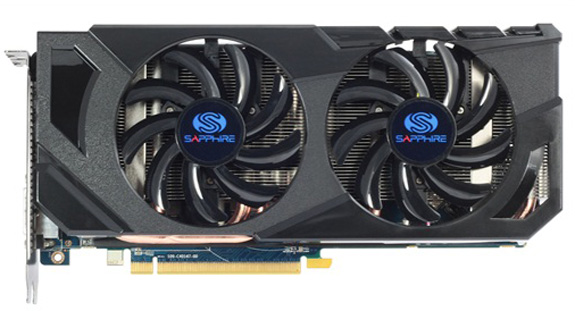
Breaking down the card, Sapphire’s cooler of choice is a slightly smaller version of their Dual-X cooler. The Dual-X is your typical double-wide dual-fan open air cooler, with 2 fans providing copious airflow over an aluminum heatsink running virtually the entire length of the card. As with the larger Dual-X cooler we saw on their 7950, the Dual-X on the 7870 is slightly oversized, allowing for slightly larger fans. In exchange the Dual-X on the 7870 is about 10mm taller than the PCB, and 0.5” longer than the 7870 PCB, pushing the card out to 10” long.
Meanwhile contact with the GPU is provided through an aluminum baseplate. Embedded in the baseplate are the card’s 4 copper heatpipes, which in turn run to various locations on the heatsink. Elsewhere Sapphire uses a small aluminum plate covering part of the PCB to function as a heatsink for the GDDR5 RAM.
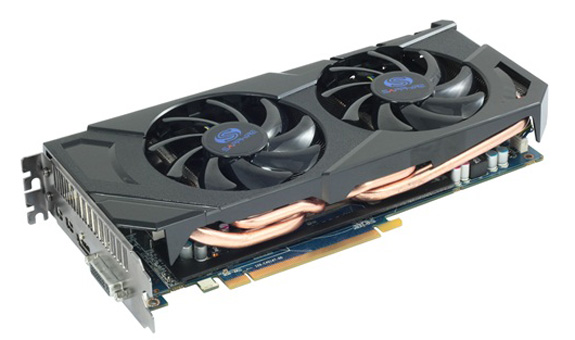
Unfortunately while Sapphire has built a good cooler for the 7870, they’ve done a subpar job on overall build quality. The cooler itself is fine, but like most other dual-fan coolers it’s only secured to the PCB around the GPU, meaning additional support for the PCB is required. In place of a full shroud providing stability there should be a stiffener running along the card, and while Sapphire’s aluminum plate provides some support it’s not nearly long enough. As a result roughly a third of the card – the tail-end portion of the card farthest from the GPU – doesn’t have any kind of support, leaving the PCB free to flex. This oversight isn’t likely to result in damage so this isn’t a dealbreaker, but at this point we’ve come to expect better, especially for cards in this price range. It goes without saying that handling the tail-end of the PCB should be avoided.
Wrapping up our look at the design of the card, as this is an AMD reference PCB the rest of the card uses the same 7870 design we’ve seen before. At the tail-end of the card are 2 6-pin PCIe power sockets, which are a bit harder to reach thanks to the oversized cooler, but not altogether difficult. Meanwhile at the front Sapphire is using AMD’s standard port configuration for display connectivity: 2 miniDPs, 1 HDMI port, and 1 DL-DVI port. Unlike some of the other 7870 cards we’ve seen, Sapphire is not using the optional second DVI port, so a full size vent is present.
Rounding out the package is the usual collection of dongles and materials. Sapphire includes 2 molex-to-6pin PCIe adaptors, an HDMI to DVI dongle, a miniDP to DisplayPort dongle, a DVI to VGA dongle, a CrossFire bridge, and a 1.8m HDMI cable. Along with the dongles Sapphire packs a quick start guide and a driver installation CD. As the driver CD itself is rather barebones Sapphire doesn’t include a copy of their TriXX overclocking utility, but at this point it wouldn’t do you any good anyhow – Sapphire has yet to update TriXX to support the 7800 series, so it can’t properly read the card. For overclocking you’ll need to use Overdrive or other 3rd party overclocking utilities.
Finally, let’s talk about pricing and warranties. Sapphire is selling the HD 7870 OE for $359, only $10 over AMD’s $349 Radeon HD 7870 MSRP. As Sapphire uses the same Dual-X cooler on their stock-clocked 7870 the $10 premium is entirely for the factory overclock, and while a similar 5% overclock should be easily attainable on virtually all 7870 cards, as far as factory overclock pricing is concerned $10 for 5% more is a reasonable deal here. As for the warranty, the HD 7870 OE ships with Sapphire’s standard 2 year warranty.
Performance
So how does the HD 7870 perform? Since the biggest differentiating factor among AMD’s partners right now is their choice of coolers, let’s start there.
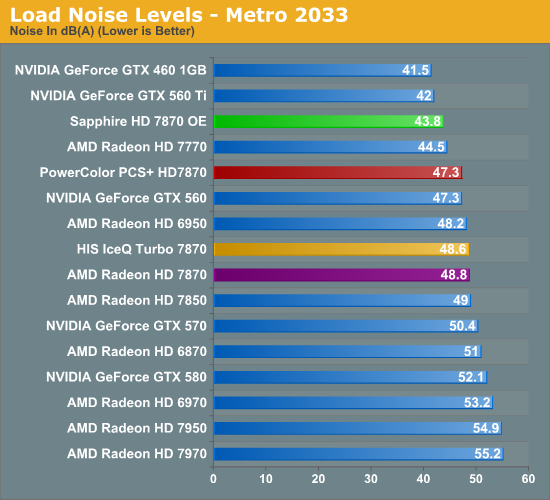
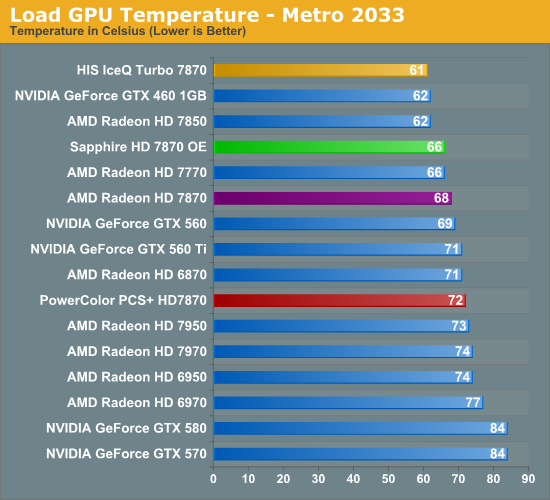
As we’ve come to expect from the Dual-X and other open air coolers, Sapphire’s cooler does very well here. Under Metro it’s by far the quietest 7870 we’ve tested, coming in at only 43.8dB, which makes it quieter than even the reference 7770 and only a few dB over our noise floor. Sapphire doesn’t make any temperature tradeoffs here either, hitting a quite cool 66C, 2C cooler than the reference 7870 and its fully enclosed blower design. With that said, the use of an open air cooler is a tradeoff in and of itself, and like other open air cards Sapphire’s 7870 needs a case with good airflow to breathe since it ends up recycling hot air.
The HD 7870 OE’s gaming performance on the other hand is not particularly exceptional for 7870 cards. The performance of the 7870 scales well with clockspeed so gaming performance benefits from Sapphire’s 5% core overclock in most situations, but looking at the big picture 5% isn’t a huge difference. In the case of Battlefield 3 it’s enough to nudge performance over 60fps, but it isn’t going to significantly change your playable settings. Ultimately there’s not a lot Sapphire can do here, as the 7870 being the higher tier 7800 series card means that it’s already running closer to the limit of the Pitcairn GPU.
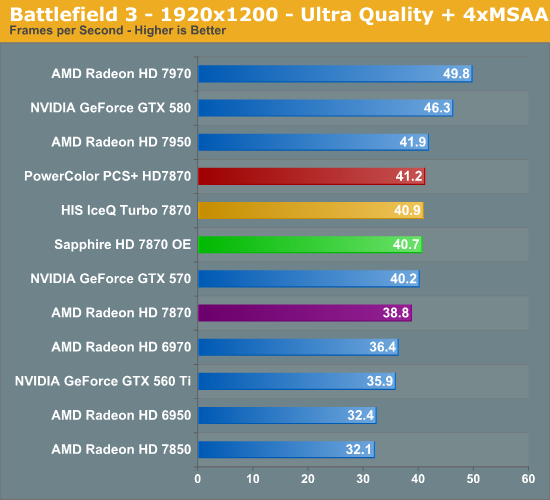
Overclocking can push the card a bit farther of course. In this case we hit 1150MHz core and 5.4GHz memory, which is a bit lower than what we’ve hit with other 7870s but since all of these cards are using the same PCB it’s purely the luck of the draw.
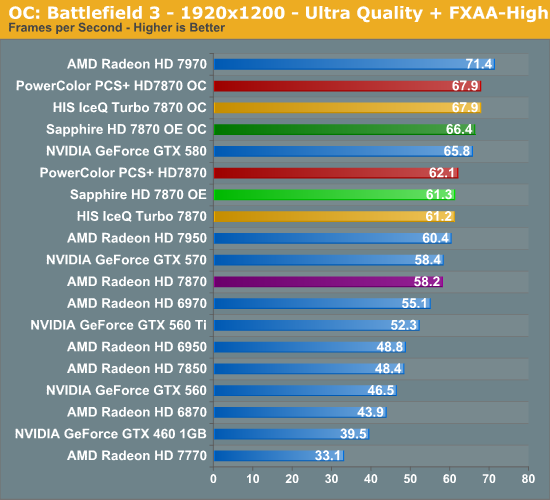
Final Words
At this point we’ve looked at several different Radeon HD 7870 designs, open air and closed blowers, extreme performance and balanced designs alike. To that end Sapphire’s HD 7870 OE fits in well with the balanced group, offering a decent factory overclock alongside a conventional but effective cooler. The subpar build quality of the card keeps it from being a true superstar, but otherwise Sapphire has done a good job here of balancing every aspect of the HD 7870 OE to make the card a solid performer.
The end result of Sapphire’s efforts is that of all the 7870 cards we’ve looked at the HD 7870 OE is easily the quietest and it doesn’t make any temperature compromises to get there. Hardcore overclockers will likely want a bit more, but for more traditional gamers with cases that can handle open air coolers this is the semi-custom 7870 to get – the HD 7870 OE offers all of the performance of a 7870 and more, and it does so with as little noise as possible. From a noise/performance perspective the 7870 is the current sweet spot, and Sapphire’s HD 7870 OE is sitting right in the middle of it.
















37 Comments
View All Comments
Ryan Smith - Sunday, April 29, 2012 - link
Because of the 190W TDP. That means you need a further 115W on top of the 75W a PCIe slot can provide,which in turn requires 2 6pin PCIe power sockets.hwhacker - Sunday, April 29, 2012 - link
I think he was asking why it needs 2x6-pin connectors when under load these things do not draw 150w. Heck, a 7950 questionably draws 150w a lot of the time, and a 7970 questionably 225w. If those were nvidia cards, they would without a doubt have less power connectors.This is probably a mix of different things, some obvious and others inferred:
Yes, TDP. AMD actually puts power connectors according to a theoretical but unrealistic 100% load and the lovely powertune rating is for product differentiation. This is a huge qualm I've had with them since nVIDIA started doing the questionable/smart choice of supplying power connectors for AVERAGE load at STOCK. IE, a 680 draws 225w at load stock, but can be clocked to draw much more because the pci-e spec is completely over-specced. This started with GTX570 iirc. Bending the rules or smart marketing...you be the judge. I wish there was a single spec that everyone agreed on, one or the other. It does make AMD look bad for what I see as playing by the rules.
Another portion is marketing. Irregardless of where AMD places their chips, there stack has been pretty consistent that the low end is 75/150w, the mid-range 150/225w, high-end 225/300w for power connectors. This almost never actually fits with their actual power consumption but does place realistic segmentation on the lower-end parts when they cannot have their voltage adjusted etc. The given rational obviously being they would climb over their pci-e spec, the reality being that lower-end products would deter buying higher-up the chain. AMD has effectively killed the 4850/5850's of the world, and 7850 looks unattractive to 7870 when if all things were equal, it shouldnt.
WRG the powertune rating, it's not tough to see through the marketing ploy of it all:
A 7870 can use a max of 190w for overclocking. Sea Islands is on the same process. Is it so cynical to think 8870 will have a ~/slightly greater stock tdp than the powertune rating of 7870 with a powertune rating of the 225w pcie spec? Think about that for a second. By doing this not only are they essentially guaranteeing the new product will perform better than the old even if the earlier had the capability (which 7870 doesn't) because the newer part can use more power, it also appears as an upgrade in technology as the average consumer sees power requirements as similar because they require the same amount of connectors. I could very much see this coming into play when comparing a 8870 to a 7950, for example, or a 7850 to 8770. Similar specs, higher frequency and tdp potential on newer parts via voltage or what-not.
plopke - Sunday, April 29, 2012 - link
:) Ty both for your reply , well was just curious AMD itself says on their website you only need one 6 pin connector. But I guess most are made with 2 for overclocking potential and given a 2-1 adapter for normal use.CeriseCogburn - Sunday, April 29, 2012 - link
If only the fantasies he filled your head with were true, but they are not.Let's take the big amd favorite game, Metro2033 in the above chart right in front of geniuses' eyes.
Here's the total power consumption in the game for a system with "these cards"
310
316
324
331
334
336
352
353 (7950 at stock clocks)
+
Now let's remove the gentleman's arbitrary declaration of low power usage:
"when under load these things do not draw 150w. Heck, a 7950 questionably draws 150w a lot of the time"
-
That leaves 160 watts for the rest of the system, or more than 202 watts in the case of the overclock, and here's the 100 watts idle usage in the release article link
http://www.anandtech.com/show/5625/amd-radeon-hd-7...
Gee, it's right there.
100 watts
Oh well, more fan fantasies and excuses are surely coming, and facing reality is the unattainable job for the spinners.
Spunjji - Friday, May 11, 2012 - link
CC, Since when did 100W idle system power mean your system besides the GPU will also be drawing 100W under load? What madness makes you think you can clatter out that sort of utter bollocks without anybody noticing?Just to demonstrate how little sense you just made:
http://www.techpowerup.com/reviews/NVIDIA/GeForce_...
Now have a look for the 7870. In case you're having trouble finding it, it has a *peak* power draw of 115W under Crysis 2. You'll note that the GTX 670 gets a commendable 152W under the same test, because it too has fucking excellent power efficiency.
Before you start your trolling some more, note that TechReport have a reliable methodology for measuring -card- power draw. Anandtech's methodology is poor for rating the cards alone because their over-specified CPU leads to compressed results under low load. I don't particularly care about that though because even if their results *were* a good indicator of card power alone, what you wrote here would still be a lousy piece of chicanery.
In short, hwhacker is right and you are so, so wrong.
medi01 - Sunday, April 29, 2012 - link
Wow, different nick, exactly same words, same post. nVidia employees trolling here? Pathetic...CeriseCogburn - Sunday, April 29, 2012 - link
Read much what you comment on instead of calling names rudely?His link goes to a Kindle Fire for $199, which by implication he would rather spend his money on.
Maybe since you're such a genius you could tell us what graphics chip is in the kindle fire, and then claim he's a Nvidia employee ? Good luck son.
Hey guess what - people can, and do, and have, especially lately, hated the overpriced amd cards !? Imagine that, they ripped me off for over $130 dollars by the way.
Guess what ? I'm not nor have I ever been employed by Nvidia, although hoinesty that would be absolutely great since they have money and hire more employees and amd doesn't and fires employees then rips people like me off too !
Yes, please direct the Nvidia headhunters to both mine and the other possibly several guys posts. ( people do copy what was written prior and repost it when they see the clueless jabbering !)
Ryan Smith - Sunday, April 29, 2012 - link
Chill guys, that was a spammer.silverblue - Sunday, April 29, 2012 - link
Amusing, considering NVIDIA actually cut 360 jobs back in late 2008. The first time in a long time, sure, but even the amazing NVIDIA loses money and employees once in a while.You're really starting to grate as regards that 7970. In the past, people might've shown some sympathy, but now, you just look like somebody with more money than sense for not waiting a bit to see how the product's early months panned out and not enough gumption to do something about a bad purchase other than bitch about it incessantly. Amusingly, if you forget the 7970 for a moment (which AMD only priced where they did because the top card always commands a much higher price - 580 anyone?), AMD are usually more competitive than NVIDIA as regards performance/$, and until Kepler, less power hungry. You had a bad experience, we know, but just because you did, doesn't mean you should come here preaching that everybody stop buying AMD products as a result. Believe it or not, having more people like you slating one company and praising the other is exactly why people get uppety about possible employees or shills posting here.
More people are going to shell out for a 7870 (or the NVIDIA equivalent, when they launch it) than the 7970 or 680. This review is concerned with the 7870, a card which undoubtedly performs notably slower to the 680, not like it would be a surprise.
Galidou - Tuesday, May 1, 2012 - link
Let him be, he's a mad fanboy looking for love, because his beloved company can't give him any. The only thing they'll do is sell him some overhyped video cards that, while being very good, aren't the holy grail of computer part that ever existed in human history! OMG people we're not comparing a Honda Civic to a Lamborghini Diablo special limited edition... get REAL LOL!!I have a radeon 6850 in one righ and a GTX 550 ti in another and both runs EVERYTHING with 80-90% of graphical options enabled... With the last 10-20% of options noticeable if you stop the rythm of the game to only look at graphics... All that AT 1080p!!!!!!!!!!
AHHH life's good...